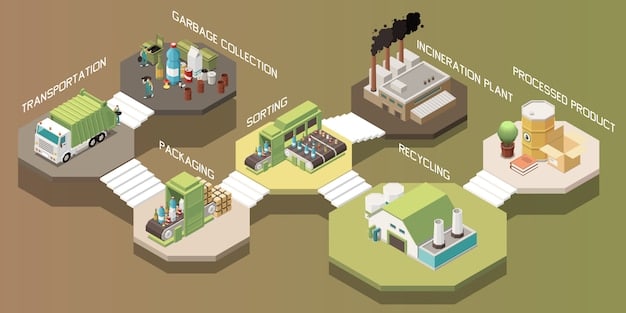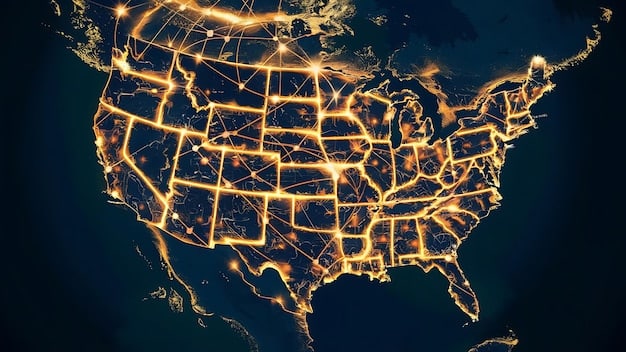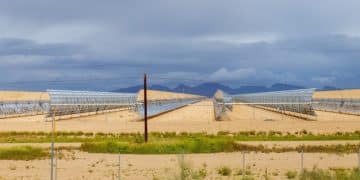Carbon Capture: Can Tech Cut US Emissions by 2050?

Carbon capture technology aims to mitigate climate change by capturing carbon dioxide emissions from sources like power plants and industrial facilities, but its viability in significantly reducing US emissions by 2050 is debated due to factors like cost, scalability, and widespread deployment challenges.
Can carbon capture technology: is it a viable solution for reducing US emissions by 2050? As the United States grapples with the urgent need to curb its carbon footprint, innovative approaches are coming to the forefront. One technology in particular, carbon capture, has garnered increasing attention as a potential game-changer in the fight against climate change.
Understanding Carbon Capture Technology
At its core, carbon capture technology involves capturing carbon dioxide (CO2) emissions from sources like power plants, industrial facilities, and even directly from the atmosphere. This captured CO2 can then be stored deep underground, preventing it from entering the atmosphere and contributing to global warming, or it can be utilized in various industrial processes.
The Basic Process of Carbon Capture
The carbon capture process generally includes chemical absorption to separate CO2 from other gases, followed by transporting the captured CO2 via pipelines to suitable storage locations or utilizing it in diverse applications. Think of it as a high-tech filter, trapping the harmful CO2 before it can wreak havoc on our atmosphere.
Different Types of Carbon Capture Technologies
There are several technological approaches to capturing carbon. The most common include pre-combustion capture, post-combustion capture, and oxy-fuel combustion. Each method has its unique advantages and challenges, making them suited to different types of emission sources.
- Pre-Combustion Capture: Involves converting fuel into a mixture of hydrogen and CO2 before combustion.
- Post-Combustion Capture: Captures CO2 from the exhaust gases after combustion.
- Oxy-Fuel Combustion: Uses pure oxygen for combustion, resulting in a concentrated stream of CO2 that is easier to capture.
Carbon capture technology holds immense potential, but its widespread adoption requires tackling several significant hurdles. We need to consider the challenges of cost, scalability, and public perception to understand its feasibility as a viable solution for reducing emissions.

The Potential Impact on US Emissions
The potential impact of carbon capture technology on US emissions is significant. By capturing and storing CO2 from major emission sources, the United States could substantially reduce its carbon footprint and move closer to achieving its climate goals. However, the actual impact depends greatly on the scale and speed of deployment.
Current US Emissions Landscape
The United States is one of the largest emitters of greenhouse gases globally, with the energy and industrial sectors being the primary contributors. Reducing emissions from these sectors is crucial for achieving the country’s climate targets. Without aggressive deployment of carbon capture and other mitigation strategies, these targets may remain out of reach.
Modeling the Impact of Carbon Capture
Various studies and models have assessed the potential of carbon capture technology to reduce US emissions. These models typically consider factors such as the cost of technology, the availability of storage sites, and the rate of deployment. The results suggest that carbon capture could play a vital role, but only if implemented on a large scale.
Scenarios for 2050 Emissions Reduction
To achieve substantial emissions reductions by 2050, the US would need to see widespread adoption of carbon capture across multiple sectors. This includes retrofitting existing power plants and industrial facilities with capture technology, as well as building new facilities with integrated carbon capture systems. The success of this vision hinges on overcoming economic, technical, and regulatory barriers.
While modeling offers insights into the potential impact, it is crucial to address the realistic challenges associated with implementing carbon capture technology at scale and ensure that it aligns with broader climate goals and sustainable development practices.
Economic Considerations and Scalability
Economic considerations and scalability are pivotal factors in determining the viability of carbon capture technology. The high costs associated with capturing, transporting, and storing CO2, along with the ability to deploy these technologies on a large scale, will greatly influence their potential to reduce US emissions by 2050.
The Cost of Carbon Capture Technologies
The cost of carbon capture technologies varies significantly depending on the type of technology used and the source of the emissions. Post-combustion capture, for example, can be particularly expensive due to the need to retrofit existing facilities. These costs pose a significant barrier to widespread adoption.
Scalability Challenges and Opportunities
Scaling up carbon capture technology requires significant investment in infrastructure, including pipelines for transporting CO2 and suitable storage sites. The availability of these resources, along with the capacity to expand the technology to numerous facilities, will determine the scalability of the technology.
Incentives and Policy Support
Government incentives and policy support are essential for driving down the cost of carbon capture and promoting its widespread adoption. Tax credits, grants, and regulatory frameworks can create a favorable environment for investment in carbon capture projects. Without such support, the economic barriers may remain too high for many companies to justify the investment.
- Tax Credits: Incentivize companies to invest in carbon capture projects.
- Grants: Provide direct funding for research, development, and deployment of carbon capture technologies.
- Regulatory Frameworks: Establish clear rules and standards for carbon capture projects, reducing uncertainty and encouraging investment.
To fully realize the potential of carbon capture, we must address the critical issues of cost and scalability, ensuring that the technology is both economically viable and capable of widespread deployment across the United States.

Environmental and Social Implications
Beyond the technical and economic aspects, the environmental and social implications of carbon capture technology must be carefully considered. The deployment of these technologies can have both positive and negative effects on the environment and local communities.
Potential Environmental Benefits
One of the primary environmental benefits of carbon capture is the reduction of greenhouse gas emissions, which can help mitigate climate change. By preventing CO2 from entering the atmosphere, we can slow down global warming and reduce the severity of its impacts. This is increasingly vital in the face of worsening climate change impacts across the globe.
Possible Environmental Risks
There are also potential environmental risks associated with carbon capture technology. CO2 storage sites need to be carefully selected and monitored to prevent leaks, which could have harmful effects on groundwater and soil. Additionally, energy-intensive capture processes may inadvertently increase other forms of pollution.
Social and Community Considerations
The deployment of carbon capture projects can have significant social and community implications. The construction of pipelines and storage facilities can disrupt local communities, and there may be concerns about the safety and security of CO2 storage. It’s essential to engage with local communities and address their concerns to ensure that projects are implemented in a responsible and equitable manner.
Addressing the environmental risks and social considerations associated with carbon capture is crucial for ensuring that the technology is deployed safely, responsibly, and in a way that benefits everyone.
Alternative Approaches to Emissions Reduction
While carbon capture technology offers a potential solution for reducing emissions, it is essential to consider it in the context of other alternative approaches. A comprehensive strategy for addressing climate change should include a mix of technologies and policies, each playing a unique role. Relying solely on carbon capture may not be the most effective or sustainable approach.
Renewable Energy Sources
Renewable energy sources, such as solar, wind, and hydropower, offer a clean alternative to fossil fuels. Investing in renewable energy can significantly reduce emissions from the energy sector and decrease our dependence on carbon-intensive technologies like coal-fired power plants.
Energy Efficiency Measures
Improving energy efficiency is another critical component of emissions reduction. By using less energy to perform the same tasks, we can reduce our overall energy demand and lower emissions. This can be achieved through measures such as improving building insulation, using more efficient appliances, and adopting smart grid technologies.
Other Innovative Technologies
In addition to renewable energy and energy efficiency, there are several other innovative technologies that could play a role in reducing emissions. These include hydrogen fuel cells, advanced biofuels, and direct air capture technologies. Each of these technologies has its own set of advantages and challenges, and they all contribute to a diverse portfolio of solutions.
Ultimately, a diversified approach that combines carbon capture with renewable energy, energy efficiency, and other sustainable solutions is most likely to result in significant long-term emissions reductions.
The Future of Carbon Capture in the US
The future of carbon capture technology in the United States depends on a variety of factors, including technological advancements, policy decisions, and public acceptance. As research and development continue to drive innovation and costs decline, carbon capture is likely to become an increasingly attractive option for reducing emissions.
Ongoing Research and Development
Ongoing research and development efforts are focused on improving the efficiency and reducing the cost of carbon capture technologies. This includes developing new materials for capturing CO2, optimizing capture processes, and finding innovative ways to utilize captured CO2. These advancements could significantly accelerate the deployment of carbon capture in the coming years.
Policy and Regulatory Landscape
Government policies and regulations will play a critical role in shaping the future of carbon capture. Supportive policies, such as tax credits and carbon pricing mechanisms, can incentivize investment in carbon capture projects and create a level playing field for clean energy technologies. Without such policies, the adoption of carbon capture may lag behind other emissions reduction strategies.
Public Perception and Acceptance
Public perception and acceptance are also essential for the successful deployment of carbon capture. Addressing concerns about the safety and environmental impacts of carbon capture projects can help build public support and ensure that projects are implemented in a responsible and transparent manner. Open communication and community engagement are key to fostering public acceptance.
The role of carbon capture in reducing US emissions by 2050 is complex and multifaceted. Despite the hurdles, significant advancements are expected in the near future that will assist the efforts being made. As progress continues, proactive measures can be implemented to bring us closer at the finish line.
| Key Aspect | Brief Description |
|---|---|
| 🏭 Capture Process | Involves capturing CO2 from sources like power plants. |
| 💰 Economic Challenges | High costs hinder widespread adoption. Government incentives are essential. |
| 🌱 Environmental Impact | Reduces greenhouse gas emissions but carries storage risk. |
| ⚡ Alternative Solutions | Renewable energy and improved efficiency are vital companions. |
Frequently Asked Questions
▼
Carbon capture technology involves capturing carbon dioxide (CO2) emissions from sources like power plants, industrial facilities, and even directly from the atmosphere, preventing greenhouse gasses and supporting lowering global warming.
▼
By capturing and storing CO2 from major emission sources, the United States could substantially reduce its carbon footprint. Carbon capture technology needs to be implemented widely for it to make a large impact.
▼
High costs hinder widespread adoption. Tax credits, grants, and regulatory frameworks can help create a favorable environment for investment in carbon capture projects which is essential for the success of carbon capture.
▼
Yes, there are potential environmental risks associated with carbon capture technology like CO2 leaks from storage sites. CO2 storage sites need to be carefully monitored to prevent leaks that could have harmful effects.
▼
Reliance on renewable energy, and making efforts improve energy efficiency is one way to lower emissions. Relying solely on carbon capture may not be the most effective as there should be a number of ways.
Conclusion
In conclusion, carbon capture technology presents a promising pathway for the United States to significantly reduce its carbon emissions by 2050. While challenges related to cost, scalability, and environmental impact remain, ongoing research, supportive policies, and public engagement will be critical in realizing its full potential. By embracing a diversified approach that combines carbon capture with renewable energy and energy efficiency efforts, the US can forge a sustainable path towards a cleaner, greener future.





